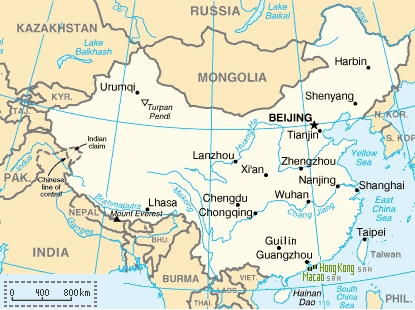CHINA

in terms of its population, 1.4 billions, china is the largest country in the world. there are many kinds of landscapes, from deserts to very high mountains. two long rivers, the yangtze and the yellow river, are essential. china has an enormous history - here are just a few bits. its first kind-of kingdom is dated 2100 b.c. from around 1500 b.c. the first empire developed in chinese areas. a lot of empires followed throughout 3000 years. in 1153 a.d. beijing became for the first time the capital city. from 1271 onwards, the mongol empire controlled china for about 100 years. the china great wall was installed over hundreds of years, and got its strongest shape in 1570. while powerful, china controlled parts of korea, mongolia and vietnam, and eventually seized tibet completely. taiwan was part of china until 1949. around 1850 china lost its might. this resulted in areas lost to great britain, i.e. hongkong, and to portugal, i.e. macao. france took over vietnam. in 1912 the 'classical time' ended, and china became a republic - a very weak one. this resulted, since 1927, in a brutal civil war, which the communist party finally won in 1949, and china then became the "people's republic" of today. in 1997 china pushed through to get hongkong and macao back, both handled as "special administrative region". their unique democracy model and international flavor may not survive though, unfortunately. the most important cities of china, besides beijing, are shanghai, and hong kong as the most international place
the photographies presented in the following result from three special visits: 1987/1988: hongkong & quangzhou (ex canton) & guilin, 2002: hongkong & macao, 2004: beijing (ex peking) & hongkong.
Technology remark:
All my pictures were made with cameras. Until 1978, most of my photography was done to create printed pictures for voyage albums. Of those, just a few got later scanned for digital pic's. These are presented in the following galleries, plus some general images of those locations.
Slide format, for creating slide series, I've used since 1975 and made my standard in 1979. Since 2000 all photo series are based on digital pic's, using "DSRL" mirror cameras (mostly 35 mm format) with a set of objectives.
